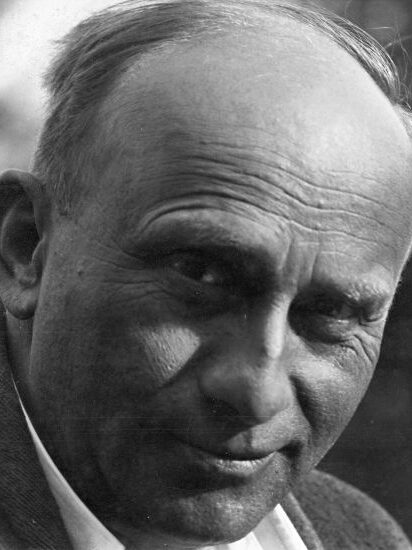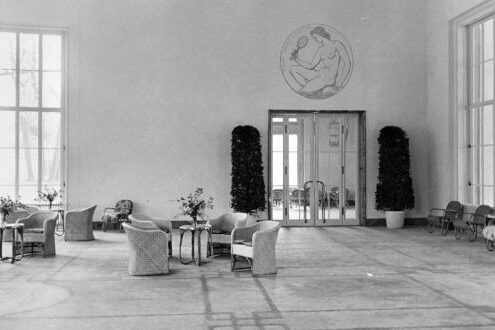Wolff-Malm, Ernst
Wolff-Malm, Ernst
Painter, Graphic artist
born: 29.04.1885 in Basel
died: 30.12.1940 in Wiesbaden
Ernst Wolff-Malm, the second of six children born to the merchant Franz Wolff (1845 - 1906) and his wife Isabella, née Malm (1862 - 1946), spent his childhood and early school years in Basel. In 1895, the family moved to Wiesbaden, his mother's home town. After finishing school, Wolff-Malm studied from 1906 to 1908 at the Grand Ducal-Baden Academy of Fine Arts in Karlsruhe under the landscape painter Gustav Schönleber (1851 - 1917) and the animal and landscape painter Julius Hugo Bergmann (1861 - 1940), in the second year as his master student. In the winter of 1908, the Banger Gallery in Wiesbaden organized a sales exhibition of 50 works by the young artist, mainly landscapes.
After completing his training, Wolff-Malm went to Rome on a scholarship, where he lived for most of the following years and studied the art of the German-Roman artists Arnold Böcklin and Hans von Marées. He also studied the theoretical foundations of pictorial conception and composition. In 1912/13 he received his first major commission, probably arranged by Hans Völcker, to execute the painterly decoration of the indoor swimming pool of the Kaiser-Friedrich-Bad, today's Kaiser-Friedrich-Therme. The fresco on the inner front wall of the hall, a wide, Mediterranean-like ideal landscape, clearly shows the orientation towards the works of Hans von Marées in the statuesque figures and the harmonious composition of the picture.
Wolff-Malm took part in the First World War as an infantryman and was wounded in the upper arm. Towards the end of the war, from June to October 1918, he was director of the museum "Au Pauvre Diable" in Maubeuge (northern France), which was set up in 1917 as part of the German "art protection" program and to which the art treasures from the Musée Antoine Lécuyer in Saint-Quentin had been brought to safety.
In Wiesbaden, he was repeatedly present in exhibitions of the Nassauischer Kunstverein e.V. from 1910 onwards, for example in February 1929, when his works were presented in the main hall of the museum in an exhibition of works with a religious theme.
From 1936 onwards, the available source material shows that Wolff-Malm's works conformed to the National Socialist view of art in terms of motifs and design. Although Wolff-Malm's designs from 1936 for an unspecified project were rejected by Hitler as "too soft and vague", his painting "Mädchen im Heu" (Girl in the Hay) was described by contemporary critics as the highlight of the exhibition at the autumn exhibition of the Gau Hessen-Nassau in Frankfurt's Römer in 1936. (Deutsches Wollen, 22.11.1936, No. 47, p. 11) And the painting "Penthesilea", shown at the Great German Art Exhibition at the Haus der Kunst in Munich in 1938, was purchased by Hitler.
During the same period, Wolff-Malm also carried out two major commissions in Wiesbaden. On the one hand, he decorated the three newly added rooms of the fountain colonnade, which had been converted into a lobby, with mosaics (1937) and, on the other hand, he provided the designs for the twelve supraports of the theater colonnade (1938), which had also been converted and painted with the twelve signs of the zodiac. Nothing has survived of either of these designs. Wolff-Malm died two years later and was buried in the family grave in the North Cemetery. In 1961, the Nassauischer Kunstverein e.V. dedicated a memorial exhibition to him at the Museum Wiesbaden.
Wolff-Malm had artistic friendships with the sculptor Arnold Hensler and his wife, the painter and photographer Annie Hensler-Möhring (1892 - 1978), as well as the architects Edmund Fabry and Eberhard Finsterwalder. Like Hensler and Fabry, Wolff-Malm was also a member of the Freie Künstlerschaft Wiesbaden, founded by Otto Ritschl in 1925. He was also a member of the Deutscher Künstlerbund until it was banned by the National Socialists in 1936.
The entire oeuvre of Wolff-Malm, who also signed his name EWM, is difficult to survey. Works can be found in private collections, in the art trade and occasionally in museums. However, he was a versatile artist. From his early landscapes, his path led him through his exploration of the German-Romans to atmospheric paintings and large-format figure compositions with religious themes. He also created numerous portraits, portfolios, frescoes and, most recently, mosaics.
Literature
- Renkhoff, Otto
Nassau Biography. Kurzbiographien aus 13 Jahrhunderten, 2nd ed., Wiesbaden 1992 (Veröffentlichungen der Historischen Kommission für Nassau 39). (Short biography no. 4848)
- Funk, Birgit
Beautiful view 9a. A place of artistic communication. In: Contemporary witnesses II. Wiesbaden houses tell their story. MATTIACA. Gesellschaft zur Pflege der Stadtgeschichte Wiesbadens (ed.), 2nd edition, Wiesbaden 2003. (pp. 162 - 167)

